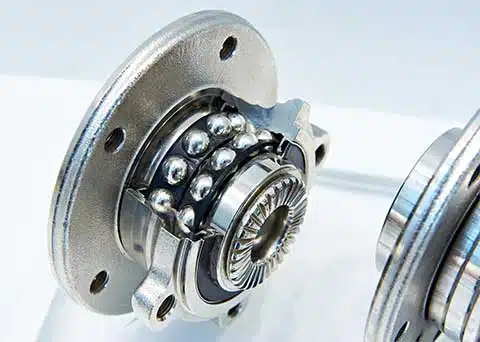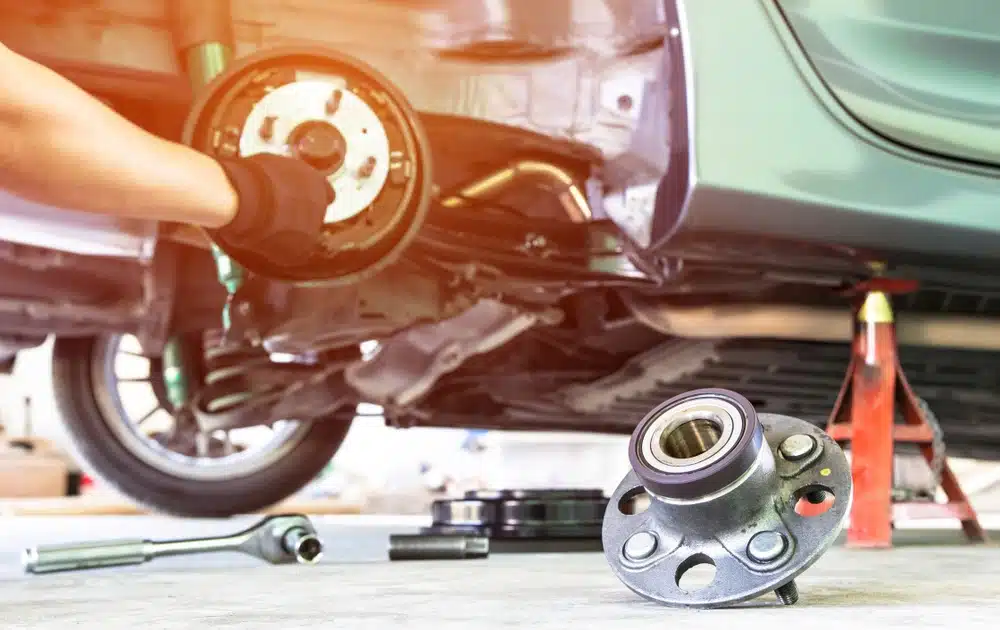Table of Contents
Bumper to Bumper and Chicks And Machines – Bearings
Many of you may already know what a wheel bearing is. But do you know exactly what its role is or when to replace it by being attentive to the signs? If not, don’t worry. I’m here to enlighten you on the subject.
A wheel bearing is an essential element that secures the wheel to the vehicle and allows it to turn easily. It is lined with small balls which are bathed in grease and which allow the wheel to turn at the requested speed without restriction.
The bearing’s components

Here is an image to better help you understand its composition.
- The inner ring
It’s on it that the gimbal will be fixed: the latter is connected to the motor and it’s that part that will make the wheel turn using the wheel bearing. - The cage
This allows the balls to stay in their place and prevents them from rubbing together and damaging each other. This is where we will put the grease to allow easy rolling between the balls. - The marbles
Obviously, they are what allow a normal and fluid rotation of the wheel. - The outer ring
It keeps all the components of the wheel bearing together.
What to check

The first signs that will help you realize that there may be problems with a wheel bearing are noises.
Here are a few you should be mindful of:
If you hear a creaking, rattling or popping sound while driving, this may indicate worn wheel bearings. This noise is more noticeable when taking sharp turns. If you hear noises coming from your wheels, it is best to contact your Bumper to Bumper adviser or your garage directly.
You may also hear a grinding noise when driving. If so, chances are your bearing is worn out. This squeak is more noticeable when you turn or when the load in the vehicle shifts. This noise warns you that there may be mechanical damage and that it would be necessary to have your vehicle checked as soon as possible by your garage.
A humming or buzzing sound can also be signs of wheel bearing wear. This noise is heard when driving in a straight line, but amplified when you turn the steering wheel to the right and to the left or when you accelerate. The worn side is usually the side opposite where the hum is coming from.
What could damage bearings?

Wheel bearings can wear out if they are damaged by road debris or if they are not sufficiently lubricated with grease.
If the wheel bearing is not properly lubricated, it will be subjected to a lot of friction, which can cause the wheel to stop suddenly. It can happen every time you drive, which is dangerous for you and others. However, most wheel bearings are sealed to prevent such a situation from occurring.
Time is the main factor that can lead to damage to a wheel bearing. Normally, the life of this component varies between 120,000 and 240,000 kilometers. It is best to refer to the manufacturer’s recommendations for exact information.
This part remains quite fragile in itself. Just overtightening the wheel or even a lack of maintenance can also contribute to premature wear of the wheel bearing. This can lead to premature replacement of the part and sometimes even damage other parts.
IN CONCLUSION
Driving with a worn wheel bearing can be dangerous, especially if it causes a wheel to stop while driving. If you hear any unusual noises coming from one side of the vehicle, and especially when turning, contact a mechanic immediately.
If you think you need a new wheel bearing, it is always recommended to have it repaired by a certified technician. This part is essential for the proper functioning of the wheels of your vehicle. Make sure your wheel bearings are properly maintained to ensure vehicle safety and performance.



